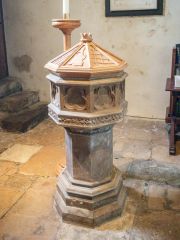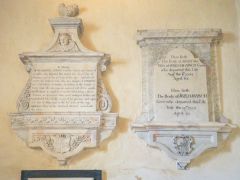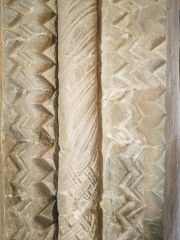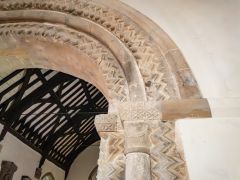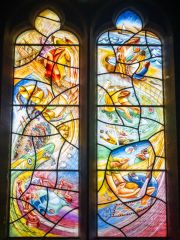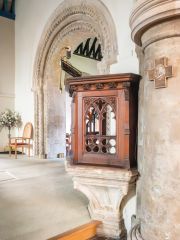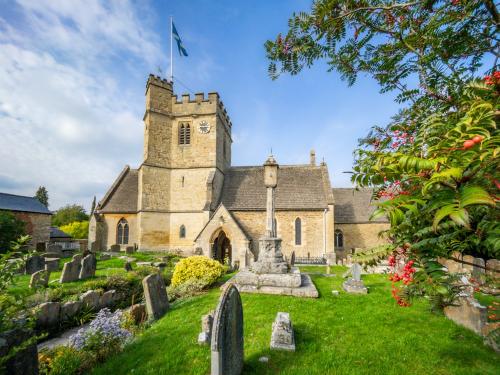
Headington is a suburb of Oxford but for most of its existence it was a separate village to the north and east of the 'City of Dreaming Spires'. Headington was a royal estate in the Saxon period and the first mention of the village comes in a deed of King Ethelred in 1004. Headington remained popular with the late Saxon monarchs and King Henry I is known to have had a residence here.
History
The oldest building in Headington is the 12th-century church of St Andrew, built around the year 1160, though a charter of Henry I mentions a church in 1122.
A south aisle and west tower were added in the 13th century and rebuilt in the 15th century. The church was enlarged in 1862.
St Andrew's is believed to have been built under the patronage of Hugh de Pluggenait, who was the Lord of the Manor of Headington from 1142-1201, a remarkable span, for the period, of 59 years.

Headington was under the patronage of the Priory of St Frideswide in Oxford until the priory was suppressed by Henry VIII in 1542. It eventually passed to the lords of the manor of Headington, where it remained until 1928 when it was transferred to Keble College in Oxford.
The oldest parts of the present building are the chancel arch and the adjoining chancel. In the chancel are 14th-century windows. The current tower dates to around 1500 and the south porch to 1598.
In the churchyard is a stepped cross dating to the medieval period, though the cross head is a modern replacement.
The church suffered from neglect over the centuries and a report in 1865 called the church 'dilapidated'.
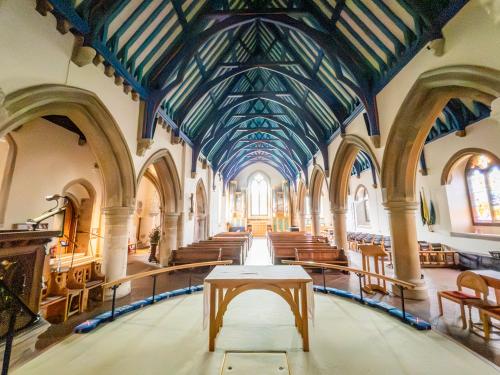
The first Norman church consisted of only a nave and chancel. To this basic rectangle was added a 13th-century south aisle, with a Lady Chapel at the eastern end. Above the Lady Chapel altar is a stained-glass window installed in 1865 by the poor of the parish in memory of Reverend John Robinson, who ministered to the poor during an outbreak of smallpox and lost his life in the process.
The touching dedication reads as follows:
'To the glory of God and in affectionate remembrance of Rev John Robinson who died November 22 1864 of smallpox contracted in the discharge of his duties as curate of this parish. By public subscription AD 1865.'

The Norman Arch
The most impressive feature of Headington's parish church is the superb 12th-century chancel arch. The arch is richly decorated with intricate carvings in traditional Norman style. You can still see traces of the original medieval paint on the stones of the arch.
The east window was inserted as a memorial to Reverend EFG Tyndale, who served as vicar of Headington from 1870-1889. A plaque in Rev Tyndale's memory is fixed to the wall. The stained glass depicts the adoration of the Magi, but if you examine it you will see that there are not three figures but four. The fourth figure is that of a knight holding a crown. This may be meant to depict one of the late Saxon kings associated with the Headington estate.
Though you cannot see them now, there are several earlier floors beneath the chancel. Beneath the present floor are two earlier tiled floors which, in turn, lie on top of a 17th-century floor built from gravestones dating to the Civil War era.
On the north wall of the chancel is a lamp that marks where the Blessed Sacrament is stored. It is a reminder of a much earlier tradition that began in the middle of the 12th century when Hugh de Pluggenait, lord of the manor, was cured of deafness, blindness, and partial paralysis. In thanks, he gave a lamp to the church with orders that it burn in perpetuity.

Stained Glass Windows
High in the westernmost window on the south wall of the chancel are fragments of original 12th-century glass.
The fine west window was installed in 1932 in memory of Vashti de Montfort Wellbourne of Barton Manor. One of the stained-glass panels depicts Simon de Montfort, Earl of Leicester and 'Founder of English Parliaments'.
The most striking window by far is the easternmost one on the north wall of the north aisle. This modern window depicts scenes from local history, including
The most striking window by far is the easternmost one on the north wall of the north aisle. This modern window depicts scenes from local history, including St Frideswide and the Morris car works.

There are several older memorials including a wall tablet to Henry North, a surgeon of Great Milton, who died in 1778. Perhaps the finest memorial is to Samuel Acton, a grocer of London, who died in 1726. Also remembered on the same memorial is Samuel's wife, Mary, who is described as:
'a person endowed with all the amiable qualifications to compleat [sic] a heavenly Mind, being a sincere Christian, and affectionate Wife, a most indulgent Mother, and kind Friend, who meekly resigned her precious Soul upon ye 9th day of May 1736 in the 67th year of her age. And was close to her Husband interred underneath this place.'
Visiting
Parking is limited near the church, but you can sometimes find parking along nearby streets. There is paid parking available at the Waitrose car park, five minutes away. We parked at the hospital, a short walk away, since we had a medical appointment, and simply strolled to the church from there. St Andrew's is usually open daylight hours and was open when we visited.
About Headington, St Andrew's Church
Address: St Andrew's Road, Headington, Oxford,
Oxfordshire,
England, OX3 9DL
Attraction Type: Historic Church
Location: On St Andrew's Road, just off Old High Street. Parking along nearby streets. Easy access from the Oxford ring road.
Website: Headington, St Andrew's Church
Location
map
OS: SP544076
Photo Credit: David Ross and Britain Express
POPULAR POSTS
HERITAGE
 We've 'tagged' this attraction information to help you find related historic attractions and learn more about major time periods mentioned.
We've 'tagged' this attraction information to help you find related historic attractions and learn more about major time periods mentioned.
Find other attractions tagged with:
NEARBY HISTORIC ATTRACTIONS
Heritage Rated from 1- 5 (low to exceptional) on historic interest
Holywell Cemetery - 1.6 miles (Historic Building) ![]()
Oxford, St Cross Church - 1.7 miles (Historic Church) ![]()
Magdalen College, Oxford - 1.7 miles (Historic Building) ![]()
Oxford Botanic Garden - 1.8 miles (Garden) ![]()
St Edmund Hall, Oxford - 1.8 miles (Historic Building) ![]()
The Queen's College - 1.9 miles (Historic Building) ![]()
New College - 1.9 miles (Historic Building) ![]()
Wadham College, Oxford - 1.9 miles (Historic Building) ![]()
Nearest Holiday Cottages to Headington, St Andrew's Church:
Witney, Oxfordshire
Sleeps: 4
Stay from: £591 - 1733
Eynsham, Oxfordshire
Sleeps: 4
Stay from: £591 - 1748
More self catering near Headington, St Andrew's Church

